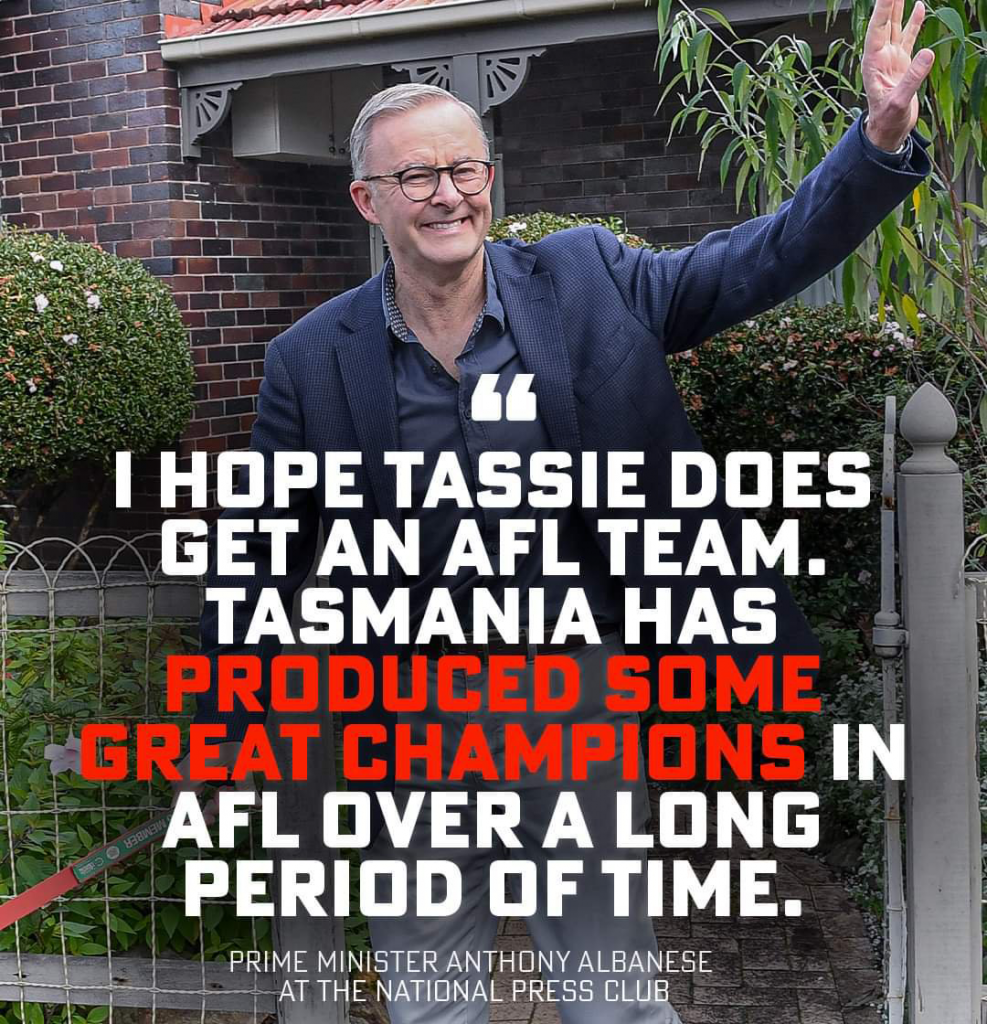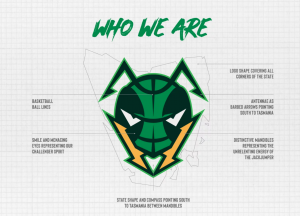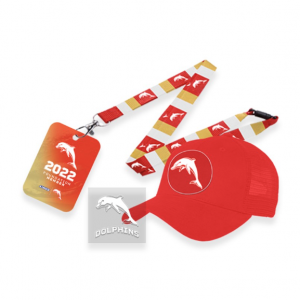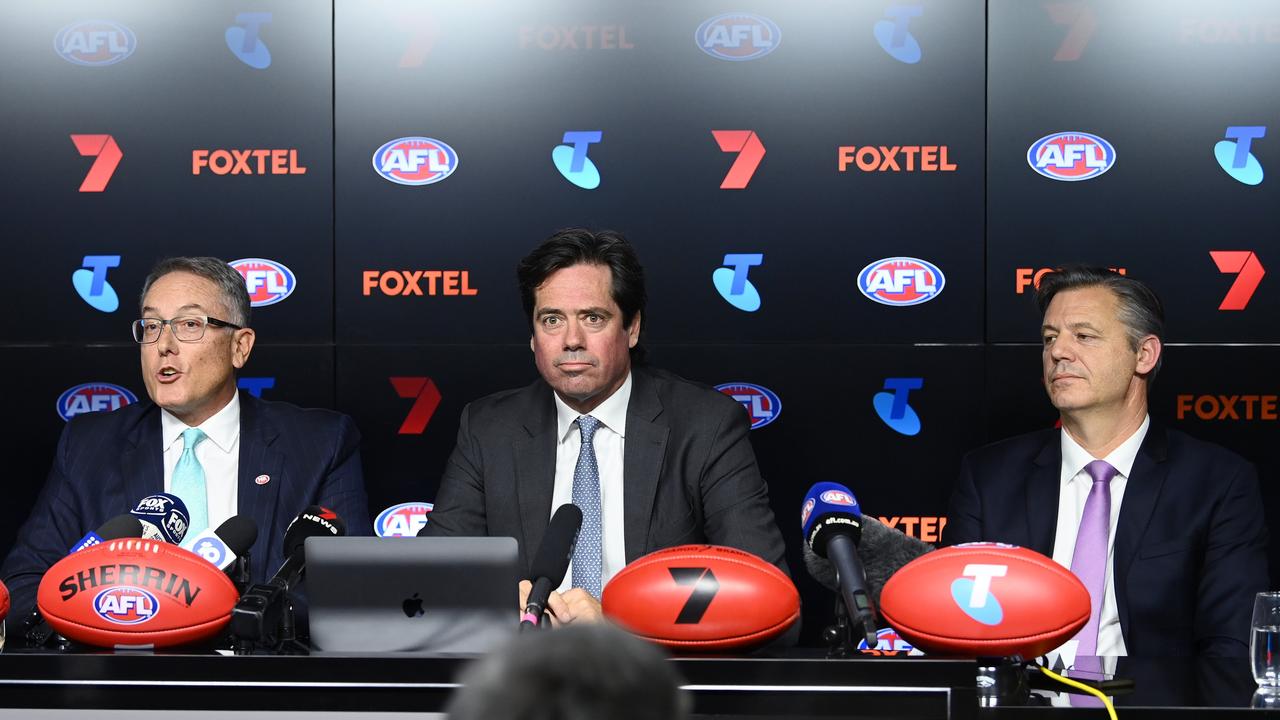
Article Authors, Left to right Jeremy Phillips-Yellend, James Fitzpatrick & Sabrine Navarro
By James Fitzpatrick, Sabrine Navarro & Jeremy Phillips-Yelland
Outgoing CEO Gillon McLachlan’s exit from AFL House relies not so much on a calendar, but on a checklist. Before he rides into the sunset, the popular league boss has a few legacy items to take care of.
He’s already secured a new TV deal, the biggest in Australian sporting history, worth $4.5 billion dollars and keeping the footy on Channel 7, Foxtel, and Telstra platforms until 2031.
And before he goes, McLachlan, as one of the eight AFL commissioners, must also make a now-or-never call on whether to award Tasmania a licence to form the competition’s 19th team.
The Apple Isle has a storied footy history – from Darryl Baldock and Royce Hart to Alistair Clarkson and the Riewoldts – which means the prospect of a Tasmanian licence has bubbled along since the 80s and 90s, when the Victorian Football League went national to become the contemporary AFL.
But the dream of a Tasmanian team has never been this close to coming to fruition.

2026 AFL Broadcast rights holders
That new mammoth broadcast deal is no impediment, as it’s fit for purpose whether the competition has 18 or 19 teams. So, what’s the hold up?
The stakeholders agree on some things, but not quite everything.
There are logistical questions to be answered. There are dollars to be found.
And throughout the bid process, there’s been a need to win hearts and minds of the public and key decision makers.
The push for a Tasmanian team sits right at the nexus of politics, policy, and public affairs.
It’s sort of issue we thrive on at Michelson Alexander, so our sports communications consultants sat down this month to map out the key stakeholders, the issues that have been addressed so far, and how the final sticking points might be addressed to get the team over the line.
Who are the stakeholders and where do they stand?
The Tasmanian Government, on behalf of its constituents, has been the loudest voice for the bid. Former Premier Peter Gutwein campaigned and negotiated aggressively, putting Tasmanian money alongside Tasmanian mouths to ensure the bid had ample traction to continue even when he left politics in April.
 Prime Minister Anthony Albanese has publicly supported the bid, but the Federal Government is yet to commit funding (more on that later).
Prime Minister Anthony Albanese has publicly supported the bid, but the Federal Government is yet to commit funding (more on that later).
But getting anywhere has always required the cooperation of the McLachlan-led AFL.
That’s because a final decision requires a vote by the AFL Commission.
And McLachlan, as a commissioner and the CEO, has stressed from the outset that the call on Tasmania requires industry consensus.
“We want this industry to own this together, and that’s a process we’re committed to. This is something the clubs have a say in,” he said ahead of Saturday’s grand final.
“I’ve said this from the outset: we are going to go forward with our industry supporting this, and if we don’t, then we won’t.
That brings us to the final stakeholder – the presidents of the current 18 clubs.
Days out from the 2022 season finale, McLachlan’s commission presented the final business case to the presidents, who will have a couple of weeks to digest and decide.
What problems have been addressed so far?
Unifying the state
Tasmanians have been donning their scarves and beanies and filling their thermoses to flock to the local footy for generations. But naysayers on the mainland have always said that divisions between the north and south, embedded since colonisation, would render one team for the whole island unsuccessful.
Many Tasmanians have long been adamant that this is not the case. The entry of the Tasmanian JackJumpers to the National Basketball League (NBL) for the 2021-22 season proved the potential of a unified team, so long as the messaging cuts through.
 The JackJumpers brand is one of inclusion and unity, “rallying passion from north to south”. Their logo, for example, quite literally sits atop a map of Tasmania, “covering all corners of the state”.
The JackJumpers brand is one of inclusion and unity, “rallying passion from north to south”. Their logo, for example, quite literally sits atop a map of Tasmania, “covering all corners of the state”.
Their mascot – the JackJumper – is a venomous ant found mainly in Tasmania.
This clear, inclusive messaging ensured most Tasmanians felt represented by their basketball team and showed how readily a Tasmanian AFL bid could follow suit.
On-court success for the JackJumpers, who were grand finalists in their first season, led to even more support, and ultimately sparked conjecture that basketball had the potential to overtake football as the Isle’s pre-eminent sport.
Were the JackJumpers mentioned in negotiations behind closed doors? We don’t know for certain, but they provide a compelling case study that debunks the idea that Tasmanians would never unite behind a single footy team.
The market
The AFL granted the Gold Coast Suns a license in 2009, facing up to the challenge of convincing fans in a rugby state to follow a southern game. After 13 years, the Suns have just 20,000 members from a population of 722,000 (2021 census), which is growing at just 2.1%.
In contrast, Tasmania – population 558,000 (2021 census) – is now the second-fastest growing state at 9.3%, according to its government. That’s remarkable, given the state grew slower than all others in the decade leading up to 2016.
And it’s a state with a generational predisposition towards footy, with memberships likely to be snapped up at much higher rate per head of capita than they are on the Gold Coast.
There’s also lessons in the NRL’s recent creation of a team that represents an enormous catchment area – including the Redcliffe Peninsula, Brisbane’s northern suburbs, the Sunshine Coast, Wide Bay, and Central Queensland – rather than any single suburb or city.
Awarded a licence in 2021 and ready to debut in 2023, the side has no geographical location in its name, and has instead been dubbed “The Dolphins”.

Dolphins membership package
For the NRL, the Dolphins will galvanise existing rugby folk, expand the code’s talent pool and increase the league’s financial performance – the same benefits the AFL could reap via a Tasmanian team.
Like the Dolphins, the Tasmanian team needs a firm economic, social, and emotional case to succeed. And landing on that case has required ongoing engagement over multiple years between the key stakeholders, including the Tasmanian Government and the AFL.
With the Tasmanian Government committing extra money to the deal this week – $204 million in total, including year-on-year funding over 12 years and $60 million upfront for a high-performance facility and team admin complex – consensus is close.
Speaking ahead of the Saturday’s grand final, CEO McLachlan confirmed that 10 of the 11 required workstreams were finalised, and that the AFL now believes there is “considerable financial, economic and emotional support for a Tasmanian team”.
What’s the final sticking point?
The stadium
In February, the Tasmanian Government unveiled plans for a 23,000-seat stadium at Regatta Point, likely to cost more than $750 million.
Then in June, McLachlan signalled that the Tasmanian bid was contingent on this new stadium in Hobart becoming a reality.
The day before Tasmania presented their formal bid to the AFL Commission, they updated the stadiums’ central location to Macquarie Point. This stadium will only be realised if the bid is successful.
Tasmania has pledged to foot half the bill, leaving $375 million to be found from either the Federal Government, or private investment.
Searching for the finish line
As it stands, the Tasmanian bid needs $375 million dollars, and a unanimous vote of the 18 club presidents.
A final date for that vote is yet to be confirmed. Collingwood’s Jeff Browne, Gold Coast’s Tony Cochrane, and Sydney’s Andrew Pridham have expressed scepticism about the 19th licence. The Federal Budget is set to be unveiled on October 25.
While funding the stadium and convincing any dissenting presidents likely go together, the task for all the stakeholders over the final month will be to maintain clear and open lines of communication.
With the AFL and the Tasmanian Government now largely seeing eye-to-eye, the long-term fate of footy on the Apple Isle rests on whether their stakeholder communications prove to be effective.
We’re tipping they’ll find a way to get Tasmania a guernsey in the national competition.
Want to dive a little deeper on the prospect of a Tasmanian team? Listen to the latest episode of our podcast HERE, Michelson Alexander Explains…, for more analysis from our sports specialists.



